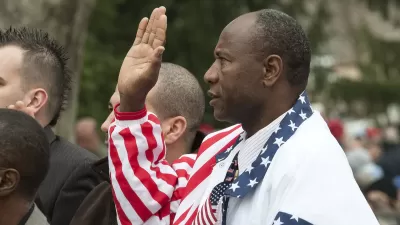Of the 20 largest metropolitan areas in the country, St. Louis had the largest percentage increase in foreign-born immigrants between 2014 and 2015.

"St. Louis notched an 8.9 percent increase in foreign-born residents from 2014 to 2015, according to data released from the U.S. Census Bureau late last week," reports Sarah Kenske. "That's larger percent increase than any of the nation's other twenty largest metro areas."
Following in second place was Minneapolis-St. Paul. Seattle, San Diego, and Houston rounded out the top five, respectively.
Fenske explains the statistical details of how St. Louis achieved the largest percentage jump in the country (also offering a caveat, of sorts):
For St. Louis, the foreign-born gains reflect an increase of about 10,623 new residents. The region as a whole is home to 2.8 million residents; just 129,559 of them are foreign-born. So while our numerical gains weren't nearly as high as many other large cities, the percentage increase shows a very real jump.
Fenske shares perspective on the effort behind the data from the St. Louis Mossaic Project, which launched in 2013 to combat sluggish immigrant growth in the region. Although the numbers are small when considered in net, their impact was significant. In 2015, the immigrant influx kept the region's population from shrinking.
FULL STORY: St. Louis Shows Biggest Gain in Foreign-Born Population of 20 Largest Metros

Study: Maui’s Plan to Convert Vacation Rentals to Long-Term Housing Could Cause Nearly $1 Billion Economic Loss
The plan would reduce visitor accommodation by 25,% resulting in 1,900 jobs lost.

North Texas Transit Leaders Tout Benefits of TOD for Growing Region
At a summit focused on transit-oriented development, policymakers discussed how North Texas’ expanded light rail system can serve as a tool for economic growth.

Why Should We Subsidize Public Transportation?
Many public transit agencies face financial stress due to rising costs, declining fare revenue, and declining subsidies. Transit advocates must provide a strong business case for increasing public transit funding.

How Community Science Connects People, Parks, and Biodiversity
Community science engages people of all backgrounds in documenting local biodiversity, strengthening connections to nature, and contributing to global efforts like the City Nature Challenge to build a more inclusive and resilient future.

Alabama: Trump Terminates Settlements for Black Communities Harmed By Raw Sewage
Trump deemed the landmark civil rights agreement “illegal DEI and environmental justice policy.”

Dear Tesla Driver: “It’s not You, It’s Him.”
Amidst a booming bumper sticker industry, one writer offers solace to those asking, “Does this car make me look fascist?”
Urban Design for Planners 1: Software Tools
This six-course series explores essential urban design concepts using open source software and equips planners with the tools they need to participate fully in the urban design process.
Planning for Universal Design
Learn the tools for implementing Universal Design in planning regulations.
City of Santa Clarita
Ascent Environmental
Institute for Housing and Urban Development Studies (IHS)
City of Grandview
Harvard GSD Executive Education
Toledo-Lucas County Plan Commissions
Salt Lake City
NYU Wagner Graduate School of Public Service




























